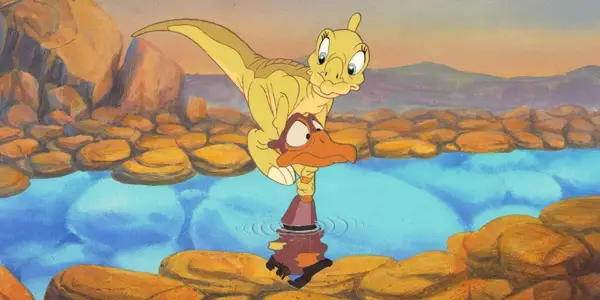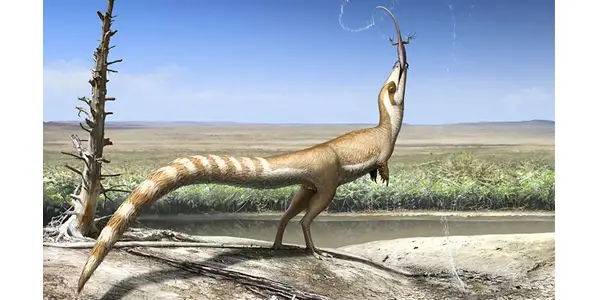Fantasy Science Pt. 29: Dinos In Sci-Fi After Dinosaur Discoveries Of The 2010s

Radha has a PhD in theoretical quantum physics. Apart from…
Have you ever wondered just how accurately sci-fi films portray real science? Well, my friends, this column is for you! Fantasy Science & Coffee, aims to bridge the gap between science and science fiction in films and popular culture. My hope is to explain things in a fun way – like we’re chatting over coffee.
You may be thinking: who is this person, why does she think she can explain science, and why the heck would I want to have coffee with her? Well, I’m Radha, a scientist based in India. I quite like hot beverages. I’ll also pay.

In this twenty-ninth part of the series published on the second Tuesday of every month, we’re going to kick off the new decade by chatting about chat epic scientific discoveries from the 2010’s that involve dinosaurs!
Dinosaurs in Science Fiction

Ah, dinosaurs, the giants who walked the earth millions of years before us, inspiring heart-warming tales such as The Land Before Time (1988) and action-packed thrillers like Jurassic Park (1993). On screen, the dino are depicted in all shapes and sizes from the sassy pink Baby “Not the Mama!” Sinclair from Dinosaurs (1991-94) to the endearingly positive blue-eyed Ducky (The Land Before Time) to the terrifying, scaley T-Rex in Jurassic Park.
Yet there’s one common factor among them: dinosaurs are mostly represented as reptilian dragon-like creatures. The truth is, we do not really know what these old-school birds looked like, though we are increasingly finding that this representation isn’t accurate. Excitingly, over the past decade, we’ve been able to learn a little more about their appearance!
What Dinosaurs Looked Like
In 2010, scientists took the fossilized feathers of a dinosaur called Sinosauropteryx, and analyzed its melanosomes, which are organelles that contain pigments. This dinosaur that walked China around 120 million years ago apparently had reddish-brown tones and stripes on its tail.

From the original paper, Fossilized melanosomes and the colour of Cretaceous dinosaurs and birds:
Spectacular fossils from the Early Cretaceous Jehol Group of northeastern China have greatly expanded our knowledge of the diversity and palaeobiology of dinosaurs and early birds, and contributed to our understanding of the origin of birds, of flight, and of feathers. […] Furthermore, the data here provide empirical evidence for reconstructing the colours and colour patterning of these extinct birds and theropod dinosaurs: for example, the dark-coloured stripes on the tail of the theropod dinosaur Sinosauropteryx can reasonably be inferred to have exhibited chestnut to reddish-brown tones.
Shortly after, the plumage color of a small feathered dinosaur was reconstructed. Take a look at this reconstruction of the glorious A. huxleyi:

If you’d like to read its official description, here’s an excerpt from the original paper, Plumage Color Patterns of an Extinct Dinosaur:
A. huxleyi was darkly colored with gray and black body plumage. The head was gray and mottled with rufous and black. Elongate gray feathers on the front and sides of the crest appear to frame a longer rufous hindcrown. Gray marginal wing coverts formed a dark epaulet that contrasted strongly with the black- and gray- spangled light primaries, secondaries, and greater coverts of the forelimb. The large black spangles of the primaries and secondaries created a dark outline to the trailing edge of the forelimb plumage. The spangles of the outermost primaries were black. The greater coverts of the upper wing were spangled with gray or black, creating an array (secondary coverts) or rows (primary coverts) of conspicuous dots. The contour feathers of the legs were gray on the shank and black on the foot. Like the forelimb, the elongate feathers of the lateroplantar surface of the hindlimb were white at their bases with broad black distal spangles.
That we can reconstruct colors from the distant past is astounding. The trick to this reconstruction capability is a combination of preservation of soft tissues like skin and feathers, which contain melanosomes, and advanced imaging technology. Researchers in the field of paleontology have only just begun this remarkable journey into dinosaur appearances, and I cannot wait to see what else they discover. And perhaps this new information may lead to more accurate and interesting portrayals of dinosaurs on screen!
The End of the Dinosaurs
Not only did we discover more about the appearance of dinosaurs in the last decade, we learned more about the impact event that wiped them out. A new timeline of the fateful day that began the end of the dinosaurs was published in 2019. A team of scientists, led by Dr. Sean P. S. Gulick, a marine geophysicist at the University of Texas at Austin, drilled into ground zero: the Chicxulub crater, underneath the Yucatán Peninsula in Mexico. Their publication depicted a day of cataclysms: raining rocks, tsunamis, and a landscape ravaged by rampant fires. Here’s a description from their paper, The first day of the Cenozoic:
Within minutes of the impact, fluidized basement rocks formed a ring of hills, which were rapidly covered by ∼40 m of impact melt and breccia. Within an hour, ocean waters flooded the deep crater through a northeast embayment, depositing another 90 m of breccia. Within a day, a tsunami deposited material from distant shorelines, including charcoal. Charcoal and absence of sulfur-rich target rocks support the importance of impact-generated fires and release of sulfate aerosols for global cooling and darkness postimpact.
The end of the dinosaurs is a topic less explored in science fiction. Perhaps as we learn more about the reality of the end of the Mesozoic Era, when dinosaurs ruled the world, amazing story potential may arise – someone call the producers of Ice Age. That isn’t to say there hasn’t been interesting portrayals of the fall of the dinosaurs in science fiction. Arguably, the most popular one is the 1994 finale of Dinosaurs. While not scientifically accurate, it is heart-wrenching and eerily relevant: the dinosaurs doomed themselves by harming nature with technology. I sign off now with the final scene, and perhaps a little food for thought as we head into a new decade:
https://www.youtube.com/watch?v=SU31c0BkKzI
More to Explore
Articles
The NYTimes: A New Timeline of the Day the Dinosaurs Began to Die Out (2019)
Smithsonian Magazine: The Colors of Dinosaurs Open a New Window to Study the Past. (2019)
The NYTimes: Drilling Into the Chicxulub Crater, Ground Zero of the Dinosaur Extinction (2016)
Papers
S.P.S. Gulick et. al. “The first day of the Cenozoic.” Proceedings of the National Academy of Sciences. (2019)
Q. Li. et. al. “Plumage Color Patterns of an Extinct Dinosaur.” Science. (2010)
F. Zhang et. al. “Fossilized melanosomes and the colour of Cretaceous dinosaurs and birds.” Nature Letters. (2010)
Does content like this matter to you?
Become a Member and support film journalism. Unlock access to all of Film Inquiry`s great articles. Join a community of like-minded readers who are passionate about cinema - get access to our private members Network, give back to independent filmmakers, and more.
Radha has a PhD in theoretical quantum physics. Apart from research, she consults on sci-fi screenplays/books. In her free time, she cosplays and irritates her three cats. Bug her on Twitter: @RadhaPyari













